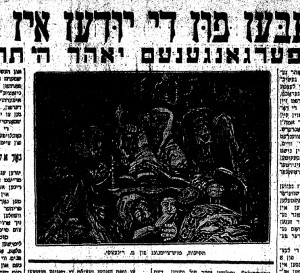An email arrives. It’s from my friend, Piotr Nazaruk, in Poland. The subject line makes my heart race. It says, “An ink drawing by M. Rynecki.” I’m in the kitchen eating breakfast. It’s early, maybe 6am. I open the email and my phone struggles to download the large PDF. Piotr explains he found the image in the Warsaw Yiddish daily newspaper, Unzer Express from September 25, 1938. “The quality is very low,” he writes. But the Yiddish is clear, it says it’s an India Ink drawing by רינעצקי, the Yiddish spelling of Rynecki.
I walk into my office and boot up my desktop computer to download the image. The black and white image slowly appears. Our internet connection this morning somehow feels throttled. I wonder if the boys are playing too many video games and eating up the bandwidth. Then the image appears, but it’s dark, and I can barely see the people in the painting. 
Piotr tells me he thinks the title is תקיעות = tkija, sound of the ceremonial shofar. “It’s hard to say what is in the painting,” Piotr hedges. “A man blowing a shofar, some books, Torah scrolls?”
I stare at the black and white reprint of the painting in a newspaper published 78 years ago, trying to see something, anything. The top and edges of the image are too dark. I look at the bottom where I think I see two figures, and older man reading a book, and a young man standing(?)/sitting(?) next to him.
“Do you know this one?” Piotr asks.
No, no I do not.
I write to my trusty Yiddish translator, Nick Block. “Can you read this?” I ask. “Does it say it’s my great-grandfather’s?”
“I’m not sure why Piotr is hedging his words so much. It certainly says what he’s translated.” Nick assures me. Then he offers a slightly edited translation of Piotr’s Yiddish. It is plural, “tekies / Tekiot,” he writes. “It means, Sounds of the Shofar or Shofar Blasts.”
I stare at the painting, willing it to become clearer, but for now it’s all I have, another partial clue in a long line of mysteries.